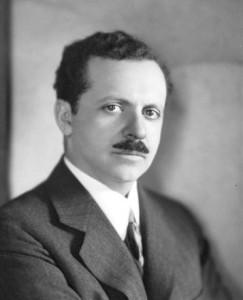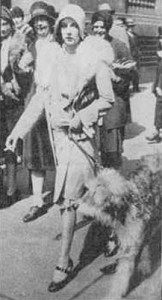“There are quiet places also in the mind, but we build bandstands & factories on them. Deliberately—to put a stop to the quietness” — A. Huxley
 When I first read about the life and deeds of Edward Bernays, I was dragging myself in a marketing/sales job. Understanding this man’s influence on the advertising world made me even more defiant of all things marketing.
When I first read about the life and deeds of Edward Bernays, I was dragging myself in a marketing/sales job. Understanding this man’s influence on the advertising world made me even more defiant of all things marketing.
During the same period I also pursued interest in minimalism, a trend promoting frugality after more than sixty years of consumerist brain-washing. This post is my take on the origins of minimalism and why it represents a sensible option to cure the past decades of shopping madness.
Mr Bernays was an Austrian-American, he’s mostly credited for coining the term “Public Relations” and for inventing advertising as we know it today. He worked for both governments and corporations, and his personal belief was that masses are ignorant, potentially dangerous and that they should be protected from themselves by a proper indoctrination.
Bernays was also Sigmund Freud’s nephew, his connection with the inventor of psychoanalysis was decisive in making him the most successful crowd-manipulator in human history.
The tool Bernays created are a fantastic way to use populations’ unconscious fears and desires in order to influence their decisions. His masterpiece remains the “torches of freedom”, a case-study worth 5 min of your time.
In the 1920’s women couldn’t smoke in the US: it was regarded as vulgar, even forbidden in some areas. As a result, Tobacco companies were missing out on half of their potential customers since guys were the only addressable segment of the American population.
Bernays was appointed by tobacco firms to unlock the situation. Although modifying a societal trend sounds like an impossible challenge, he did that in a couple of years by hacking into America’s collective unconscious.
The task at hand was to sell cigarettes to women and the blockage was the bad image it was associated with. As a marketer, Bernays needed to attach the concept of a cigarette to something desirable, something that would make a smoking woman not only OK, but extremely cool (or whatever cool was called at the time).
He quickly found the gap to fill: power. Women were frustrated to be still treated as second class citizens. They regarded themselves as disempowered members of society (and by all accounts, they were). There was clearly a need to satisfy.
 On the other hand, cigarettes could be looked as a phallic symbol, a symbol of power from the point of view of psychoanalysis. Cigarettes could make perfect phallic substitutes for the modern woman, as long as the idea was presented subtly enough. With this evil strategy in mind, Bernays paid famous models to publicly smoke during mediatic events and rebranded cigarettes the “Torches of Freedom”.
On the other hand, cigarettes could be looked as a phallic symbol, a symbol of power from the point of view of psychoanalysis. Cigarettes could make perfect phallic substitutes for the modern woman, as long as the idea was presented subtly enough. With this evil strategy in mind, Bernays paid famous models to publicly smoke during mediatic events and rebranded cigarettes the “Torches of Freedom”.
That was it.
Quickly after these staged events, smoking became the real badass thing to do for females. Sales took off, and with much fanfare the golden age of consumerist propaganda was born.
Bernays had understood how to leverage the unconscious fears and hopes of the public, and generations of marketers followed his model, hijacking human values and substituting them with corporations’ goods and services.
The idea is simple: identify something your customers want (attention, sex, power, spirituality, you name it), associate it with whatever that is you need to sell and you got a deal.
We’re easier to influence than we think.
This method has been widely abused for several decades, in fact, if you’re reading this article, you’ve probably been conditioned with the very same technique.
I’m sure you can’t visualize a bottle of fine whiskey without a gorgeous female standing next to it. That’s what I’m talking about.
While this commercial brainwash was unlimited bliss for business, it came at a high cost for the western society: the deep human needs normally fulfilled by spirituality and a balanced social life were now exclusively addressed by major brands.
And it didn’t work: you might be able to alleviate your male anxieties driving the latest Hummer, but you can’t tamper with the fear of death with a wider sofa, it takes more than products to be happy.
Now here we are, after decades of consumerist hysteria , the developed world is waking up with a huge hangover, the dream land of prosperity ended up with overstressed individuals working three jobs to reimburse a house full of gadgets they don’t get to enjoy.
The antidote modern humans have found is called Minimalism, the philosophy of amassing less goods and working less so you have more time to take care of things that matter.
It makes sense, as the economy slows down. And you can only enjoy this much possessions, anyway.
Being a Minimalist means that you don’t silence your minor aches and frustrations with a TV show or an online purchase, but you choose to address them like a gardener, by meditating, exercising, reading, taking your time.
Minimalism is an organic response to a diseased system, it’s a movement of individuals who have decided to put a priority on the things money can’t buy, weird activities like seeing their kids grow, cooking and riding a bike.
Supposedly, you shouldn’t hear about minimalism in commercials, since this movement has nothing to sell, but I guess if Edward Bernays was still alive, he’d manage to convince you to pay for the priviledge of spending less. Or something like that.
Different sellers are competing to train different behaviors, but what they all have in common is that they discourage personal growth — because growth leads to increased fulfillment and increased fulfillment leads to decreased sales. – David Cain “How to change the world”